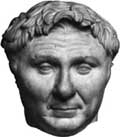In 138 BC, Junius Brutus established a small colony of Roman soldiers on an island in the river Turia, known as Valentia. Although the area had been previously inhabited by unorganized Iberian tribes, this is considered to be the founding of Valencia.

Valentia wasn’t an important city, paling in comparison to the wealthy northern port of Sagunto. But though it constantly battled the twin threats of flooding from the Turia and invasions from the ever-present Iberian natives, Valentia slowly gained traction and prominence… until 75 AD when Pompey razed it to the ground in retribution for having supported Quintus Sertorius in a civil war. Valentia was completely destroyed, its ruins existing uninhabited for half a century afterwards. Though general history respects him as a wise and noble leader, you’d probably have a hard time finding any monuments to Pompey in Valencia.
Over the next few hundred years, people began to return and Valentia was rebuilt as a more important part of the Roman empire. This is the period which saw the torture and death of San Vicente Mártir, an event credited with bringing Christianity to the city, and the establishment of administrative works and efficient Roman infrastructure, including a “Circo Romano” — a chariot track. Able to enjoy a couple centuries of relative peace & prosperity, Valencia became a major Mediterranean port.
Good times, of course, didn’t last. Once the Roman Empire began to crumble, Valencia and the rest of the peninsula fell into the hands of the Visigoths.
If you’re interested in Roman ruins, the best place to see them is actually in nearby Sagunto. The small city, about an hour north of Valencia, boasts a magnificent Roman forum (still in use) and many other ruins. But if you don’t have the means for a day trip, the archaeological site at the Plaza de la Almoina also has ruins from Roman times. It’s right in the middle of the city and is a must see.
And for history buffs, a visit to the History Museum of Valencia is an absolute must. A fascinating journey through 2000 years of they city’s history, from 138 BC to the present day. There are English guides, and all of the audio-visual exhibits are in English as well.
Pingback: Sagunto: City of Ruins | Hola Valencia Blog
Pingback: El México de Maria – Great Mexican in Ruzafa | Hola Valencia Blog
Pingback: Hola Valencia’s Top Five: Plazas